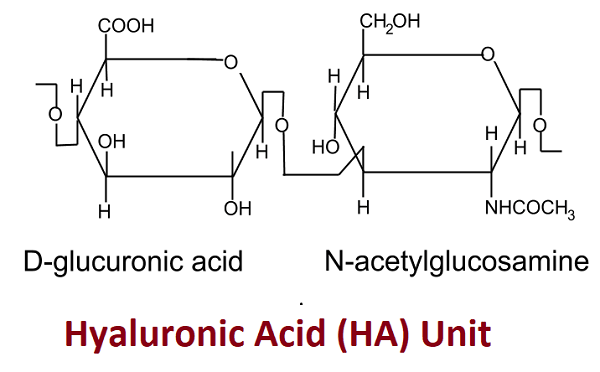Hyaluronic AcidHyaluronic Acid (HA) is a natural acid. It plays the role of cushion and lubricant in the joints and other tissues. This acid is a glycosaminoglycan that is found naturally throughout the body such as in the eyes and joints. Glycosaminoglycans are long unbranched carbohydrates or sugars called polysaccharides. Hyaluronic is also called hyaluronan or hyaluronate. It is present in many living tissues and fluids, however, it is present abundantly in articular cartilage and synovial fluid (SF). It is a non-sulfated, naturally found non-protein glycosaminoglycan (GAG). A glycosaminoglycan (GAG) for the first time is isolated in 1934 by Karl Meyer and John Palmer from the vitreous humor of the bovine eye and named it hyaluronic acid. This name was derived from hyaloid (which means vitreous) and uronic acid. Structure of Hyaluronic AcidHA is a linear anionic nonsulfated glycosaminoglycan made of two units: B-1, 4-d-glucuronic acid and B-1, 3-N-acetyl-d-glucosamine. Its chemical formula is (C14H21NO11) n. 
Benefits
3 Types of Hyaluronic Acidi) Hydrolyzed hyaluronic acid: This type is broken down into small elements that can easily penetrate the skin. It may be less moisturizing than other of its types so it is good for people who have oily skin or combination skin and want to avoid over-moisturizing. ii) Sodium hyaluronate: This type of hyaluronic acid penetrates deeper into the skin and is more effective. It is good for normal skin. However, its effect may not be long-lasting. It is also one of the ingredients in serums. iii) Sodium acetylated hyaluronate: It offers the same benefits as sodium hyaluronate but its effects are long-lasting. So, it is good for people with dry skin or who live in dry regions or for those who need a moisturizer for the dry winter months. Hyaluronic acid is available in different forms:
Side EffectsGenerally, it has no side effects as it is produced naturally in the body. So, there are very less chances of allergic reactions to using hyaluronic acid. However, when injected, it may cause the following symptoms:
Who should avoid hyaluronic acid?Hyaluronic acid may not suitable for everyone. People with the following conditions should about it. People with allergies: Some types of hyaluronic acid are produced from a rooster's comb, so the people who are allergic to chicken feathers, eggs, etc., should use it with caution. People who have had cancer: People who have a history of cancer should avoid oral hyaluronic acid as it has been found in a study that this acid can promote cell growth and may increase the chances of cancer recurrence. Kids, pregnant and breastfeeding women: The safety of its use has not been established in children and during pregnancy, so these people may avoid using it. People with scleroderma: Scleroderma refers to the hardening of the skin and connective tissue. When hyaluronic acid is applied to the skin it may worsen the skin ulcers in people who have scleroderma.
Next TopicLactic Acid
|
 For Videos Join Our Youtube Channel: Join Now
For Videos Join Our Youtube Channel: Join Now
Feedback
- Send your Feedback to [email protected]
Help Others, Please Share










